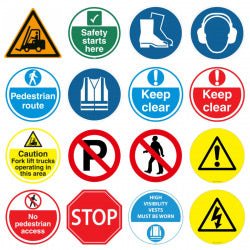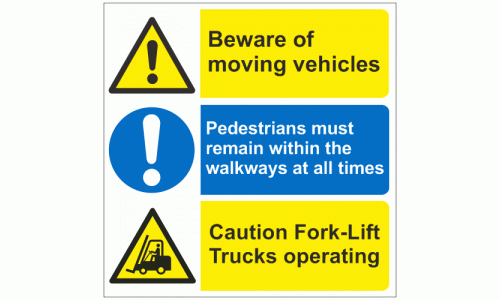Long Lasting Forklift Truck Safety Signs-- Make Certain Conformity in Your Center
Long Lasting Forklift Truck Safety Signs-- Make Certain Conformity in Your Center
Blog Article
Key Factors To Consider for Creating Effective Forklift Safety And Security Indications
When developing effective forklift safety signs, it is crucial to take into consideration a number of fundamental elements that jointly ensure optimum presence and clarity. High-contrast colors combined with huge, legible sans-serif font styles substantially boost readability, especially in high-traffic areas where fast comprehension is important. forklift signs. Strategic positioning at eye level and using sturdy products like aluminum or polycarbonate further contribute to the longevity and efficiency of these signs. Adherence to OSHA and ANSI standards not only standardizes safety and security messages but additionally reinforces compliance. To fully comprehend the intricacies and best practices included, a number of extra factors to consider quality closer focus.
Color and Contrast
While designing forklift safety indicators, the selection of color and comparison is extremely important to making certain presence and performance. The Occupational Security and Wellness Administration (OSHA) and the American National Requirement Institute (ANSI) give guidelines for using colors in security indicators to systematize their meanings.
Reliable comparison in between the history and the text or signs on the indication is equally vital. High contrast makes certain that the indication is readable from a range and in varying illumination problems. As an example, black message on a yellow history or white text on a red history are combinations that stand out prominently. Furthermore, making use of reflective materials can enhance exposure in low-light settings, which is frequently a factor to consider in warehouse settings where forklifts operate.
Making use of appropriate color and comparison not only complies with regulatory standards but likewise plays an essential role in maintaining a safe workplace by making sure clear interaction of threats and guidelines.

Font Style Size and Style
When designing forklift safety signs, the option of typeface dimension and style is vital for making sure that the messages are understandable and promptly comprehended. The main objective is to enhance readability, especially in environments where quick data processing is important. The font style dimension ought to be huge enough to be checked out from a distance, accommodating varying sight conditions and guaranteeing that personnel can understand the indication without unneeded pressure.
A sans-serif typeface is commonly advised for safety and security indicators as a result of its tidy and simple appearance, which boosts readability. Font styles such as Arial, Helvetica, or Verdana are frequently preferred as they do not have the elaborate details that can cover essential info. Uniformity in font design across all safety signs help in producing an uniform and professional appearance, which better strengthens the importance of the messages being shared.
In addition, emphasis can be accomplished via calculated use of bolding and capitalization. Keyword or phrases can be highlighted to attract instant attention to vital instructions or cautions. Nevertheless, overuse of these techniques can cause visual mess, so it is essential to use them sensibly. By meticulously picking appropriate typeface sizes and designs, forklift safety and security signs can efficiently connect crucial security details to all personnel.
Positioning and Presence
Making certain optimum positioning and visibility of forklift safety indications is vital in commercial settings. Appropriate indicator positioning can substantially lower the risk of mishaps and boost total office safety. Signs need to be placed at eye level to guarantee they are conveniently noticeable by drivers and pedestrians. This typically means positioning them in between 4 and 6 feet from the ground, relying on the ordinary height of the workforce. my latest blog post

Indicators should be well-lit or made from reflective materials in dimly lit locations to guarantee they are noticeable at all times. By meticulously thinking about these elements, one can make certain that forklift security indicators are both effective and noticeable, consequently fostering a safer working setting.
Product and Resilience
Choosing the ideal products for forklift security indicators is essential to ensuring their long life and performance in industrial environments. Given the severe conditions commonly run into in stockrooms and making centers, the materials selected need to stand up to a range of stressors, including temperature changes, wetness, chemical direct exposure, and physical effects. Sturdy substrates such as light weight aluminum, high-density polyethylene (HDPE), and polycarbonate are preferred selections because of their resistance to these aspects.
Aluminum is renowned for its robustness and corrosion resistance, making it an exceptional selection for both interior and exterior applications. HDPE, on the various other hand, provides extraordinary impact resistance and can sustain extended exposure official site to harsh chemicals without weakening. Polycarbonate, recognized for its high effect stamina and clarity, is usually utilized where presence and longevity are extremely important.
Equally vital is the sort of printing made use of on the indications. UV-resistant inks and safety coverings can dramatically enhance the life-span of the signage by preventing fading and wear triggered by prolonged direct exposure to sunshine and other ecological factors. Laminated or screen-printed surfaces give additional layers of security, making certain that the critical security details remains readable with time.
Buying top notch materials and durable production processes not only prolongs the life of forklift safety and security indicators but likewise reinforces a culture of safety and security within the office.
Compliance With Regulations
Sticking to regulative criteria is paramount in the design and implementation of forklift security indicators. Compliance makes sure that the indicators are not just effective in conveying vital safety and security details yet also meet legal responsibilities, therefore alleviating potential liabilities. Different companies, such as the Occupational Security and Health Management (OSHA) in the United States, offer clear guidelines on the specs of safety signs, consisting of shade systems, message size, and the inclusion of globally identified icons.
To abide by these regulations, it is crucial to carry out a thorough evaluation of relevant requirements. For example, OSHA mandates that safety and security indicators need to be visible from a range and consist of certain colors: red for danger, yellow for caution, and environment-friendly for safety and security directions. In addition, adhering to the American National Standards Institute (ANSI) Z535 collection can additionally enhance the effectiveness of the indicators by systematizing the design components.
Furthermore, routine audits and updates of security indications should be carried out to guarantee ongoing conformity with any type of adjustments in guidelines. Involving with licensed safety and security professionals throughout the style stage can additionally be beneficial in guaranteeing that all governing demands are met, which the signs offer their intended function effectively.
Final Thought
Creating effective forklift safety signs needs imp source mindful attention to shade contrast, typeface size, and style to ensure ideal presence and readability. Strategic placement at eye degree in high-traffic locations enhances recognition, while the use of durable products makes certain longevity in different ecological conditions. Adherence to OSHA and ANSI guidelines systematizes safety messages, and integrating reflective products increases exposure in low-light scenarios. These considerations collectively add to a much safer working setting.
Report this page